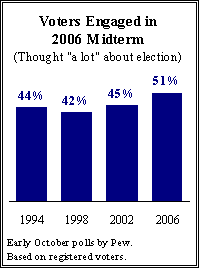
Turnout in the 2006 midterm election may well be higher than normal, given the level of interest expressed by voters. Today, 51% of voters say they have given a lot of thought to this November’s election, up from 45% at this point in 2002 and 42% in early October of 1998. Even in 1994 – a recent high in midterm election turnout – just 44% of voters had thought a lot about the election in early October.
The difference this year is due to record-high levels of Democratic enthusiasm about the election. Currently, 59% of Democratic voters say they have given a lot of thought to this election, up from 46% at this point in the 2002 election. Republicans, by comparison, are no more or less engaged this year than four years ago (48% now, 47% in 2002). Democrats are also far more excited about voting this year, with 51% saying they are more enthusiastic about voting than usual, up from 40% in 2002. Just a third of Republicans say they are more enthusiastic about voting than usual, down from 44% four years ago.
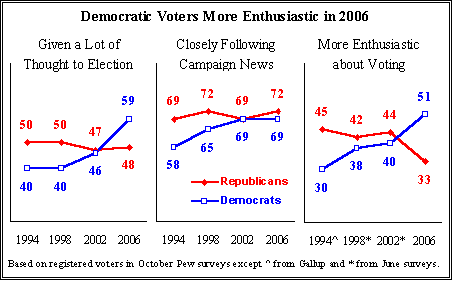
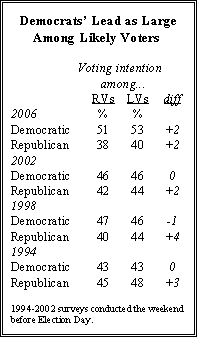
Notably, the ongoing scandal involving former Rep. Mark Foley has not had much of an impact on either the engagement or enthusiasm of Democratic and Republican voters. The Democratic advantages on both dimensions were about the same after Foley resigned as before the congressman stepped down.
The comparison between the current campaign and the 1994 midterm election, when Republicans won the majority of House votes and picked up more than 50 seats, is particularly telling. In early October 1994, 50% of Republican voters had already given a lot of thought to the election, compared with 40% of Democratic voters. Today, this margin is nearly reversed, as 59% of Democrats have given a lot of thought to the 2006 midterm, compared with 48% of Republicans.
These indications of Democratic engagement suggest that the turnout advantage the GOP has enjoyed in recent elections may not hold this November. Current estimates suggest that Democratic enthusiasm may compensate for some of the demographic factors that often lead to lower Election Day turnout among Democrats.
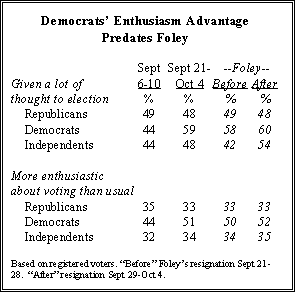
In Pew’s latest survey, conducted in collaboration with the Associated Press Sept. 21-Oct 4 among 1,503 registered voters, the Democrats hold a 51% to 38% edge among registered voters – largely unchanged from surveys conducted over the past year. When the sample is narrowed to likely voters, the Democratic advantage remains at 13 points: 53% of likely voters saying the plan to vote for the Democratic candidate in their district, and 40% for the Republican candidate.
The current survey was in the field for eight days prior to Foley’s resignation on Sept. 29, and six days after his resignation. When these two periods are compared there are no substantial differences that suggest the event itself was a turning point.

Before Foley’s resignation, 58% of Democratic voters said they had given a lot of thought to the election, and 50% said they were more enthusiastic about voting than in previous elections. Those numbers were largely unchanged in the days after Foley stepped down. And Republican enthusiasm about voting, while continuing to be lower than among Democrats, did not slip in the wake of the Foley revelations (33% before Foley resigned, 33% after).
Democrats Angry, But Optimistic About Prospects
Two clear factors underlie Democratic engagement this year – anger about the current political leadership and optimism about the party’s chances. Across every question about politics and government, Democrats express high levels of dissatisfaction, especially with President Bush. Fully 77% of Democratic voters very strongly disapprove of the job Bush is doing as president, and nearly two-thirds (63%) say they consider their vote this fall as a vote against Bush.
Democratic frustration goes beyond just the President. Most Democratic voters (57%) say this Congress has accomplished less than other recent Congresses, and the vast majority expressing this opinion say Republican leaders are to blame (88%). And when asked whether they are “angry,” “frustrated,” or “basically content” with government these days, 28% of Democratic voters say they are angry. This is up from 20% in 2004 and just 11% in 2000. More important, in 2000 there was no partisan divide in feelings of anger toward government, while today four times as many Democrats as Republicans say they are angry at government.
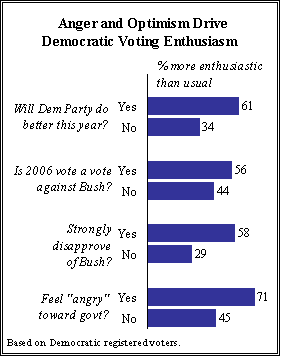
This anger plays a large role in the high level of enthusiasm among Democratic voters. Fully 71% of Democratic voters who describe themselves as “angry” at government say they are more enthusiastic about voting this year, compared with 45% of those who are “frustrated” or “basically content” with government. Similarly, Democrats who register strong disapproval of the president are far more likely to be eager to vote than those with less strong views (58% vs. 29% enthusiastic). And 56% of Democrats who say their congressional vote is a vote against the president express high enthusiasm about 2006, compared with just 44% who say Bush is not a factor in their vote.
Overall, anger is a much stronger factor in turnout for Democrats than it is for Republicans and independents. When six questions measuring various types of dissatisfaction and frustration with government are combined into an index, voters can be scored as to how angry they are relative to others. Fully 63% of Democrats who score high on this index say they are more motivated to vote this year than usual – this compares with just 44% of “angry” Republicans and 42% of “angry” independents

Another factor driving up Democratic enthusiasm is optimism about the party’s prospects in this midterm. Nearly two-thirds of Democrats (65%) say they think the party will do better in 2006 than it has in other recent elections – 28% say they will do about as well as they have, and just 2% see the party doing worse than usual this year. And the more optimistic Democrats are, the more engaged they are – 61% of those who think the party will do better are more enthusiastic about voting than usual, compared with just 37% of those who do not predict Democratic gains this fall. Republicans’ expectations are more modest for the upcoming elections: More than half of Republican voters (57%) say their party will do about the same as in recent elections; 22% think the party will fare worse; and just 15% of Republicans think the GOP will do better than in recent elections.